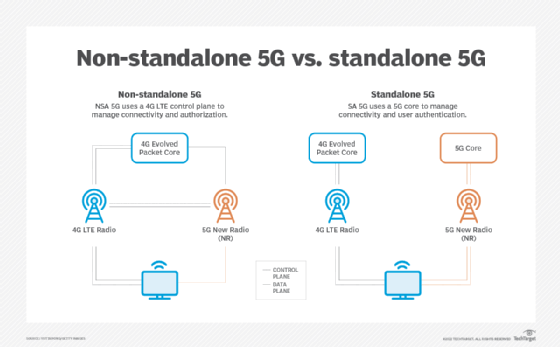5G standalone (5G SA)
What is 5G standalone (5G SA)?
5G standalone (5G SA) is a cellular infrastructure built specifically for 5G services by implementing 5G standards and protocols in the radio network and controller core. 5G standalone is also referred to as standalone 5G, or SA 5G.
Most carriers in the United States and elsewhere have deployed 5G in a hybrid mode called 5G non-standalone (5G NSA). With 5G NSA, carriers use new 5G radio equipment but layer it over the existing 4G LTE core.
Because the 5G radio access network (RAN) enables use of 5G frequencies, 5G-equipped endpoints receive some of the promised benefits of 5G -- mainly higher connection speeds with some improvements to latency. However, the full 5G feature set is not available in a hybrid network, even to 5G endpoints, and the high end of 5G performance is still out of reach.
5G SA is a true 5G network, end to end, using 5G radios on the edge and a 5G core. 5G standalone offers all the intended benefits of 5G and is not subject to the limitations of 4G LTE. On the other hand, 5G NSA uses the 4G LTE core and cannot offer any 5G functionality beyond the radio connectivity.
Why is 5G standalone important?
While faster downloads and higher-speed links to online applications are great for individuals, enterprises want and need more from 5G. Enterprises can use 5G for site connectivity more broadly and cost-effectively than 4G LTE services. Enterprises also want 5G to be a more reliable and flexible alternative to Wi-Fi. Wi-Fi use cases revolve around user devices, such as laptops, phones and tablets, and around internet of things (IoT) deployments.
Unlike 5G NSA, 5G standalone supports ultra-high-density deployments, such as IoT use cases involving dense populations of sensors and controllers in smart buildings. 5G SA can support up to 1 million devices within a single square kilometer. It also supports ultra-low-latency use cases that 5G NSA cannot, such as real-time control of robotic equipment in a warehouse or factory.
And, of special interest to enterprise site connectivity, 5G SA supports network slicing, a deployment mode that enables different devices and customers to get dedicated network partitions, like virtual private cellular networks, with specified performance guarantees, such as minimum and maximum throughput rates. 5G NSA cannot support slicing.

How does 5G standalone work?
5G SA employs both a 5G-compliant RAN and a 5G-compliant core, which is a combination of traditional core and edge infrastructures.
5G devices, such as phones, hotspots, cars or fixed-wireless modems, use radio in frequency ranges specified in the 5G standards to establish connections to 5G access points (APs) via new generations of antennas. The new antennas enable many of the improvements to signal reach, device throughput and device density.
APs communicate with 5G controllers in the edge and the core that manage device connections and connectivity across the provider's networks. Within edge and core compute clusters, 5G standards rely on modern computing principles, such as virtualization and a microservices architecture comprising containers and a container orchestration platform.
Consequently, 5G network operators can move functionality from edge to core to edge, scale up and down easily and transparently, and run core functionality in both private and public cloud and edge infrastructures.
What are the benefits of 5G standalone?
When the full 5G feature set is supported, enterprises can realize the following benefits:
- Further improvements to speed and reach, beyond what 5G NSA brings.
- Support for higher-density deployments of devices.
- Support for low-latency and real-time use cases.
- Support for enhanced enterprise site connectivity via network slicing.
- Better security than 5G NSA.
- Simplification of the RAN and core compared to 5G NSA since 5G SA supports only 5G and leaves 4G and older standards behind -- and even though the 5G SA core alone is more complex than a pure 4G core alone.
Should enterprises use 5G standalone?
Yes, enterprises should use 5G SA. Without it, they won't get the full benefits from adopting 5G.
5G non-standalone is not much better than 4G LTE as far as supporting the full array of potential enterprise use cases for cellular data services. 5G NSA is valuable as a bridge technology, enabling enterprises to cycle in 5G-ready equipment while carriers transition their infrastructures, but it's only intended as a transitional mode. The goal is 5G SA.
Enterprise communications engineers should keep in mind, though, that 5G SA cores are new code stacks implementing new protocols. On the one hand, that can mean leaving behind the bugs and fixes of older systems, and the inevitable outcome is a patchwork, such as 5G NSA, with risks to function or security. On the other hand, new code is, by definition, less tried and tested, so it has the potential for surprising and dangerous bugs of its own.







